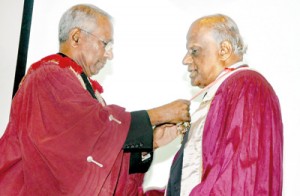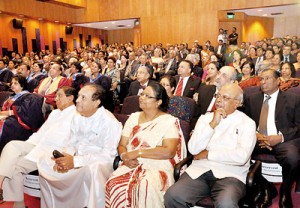News
New SLMA chief wants priority for children, elderly and disabled
By Kumudini Hettiarachchi
It is time not only to look forward but also to look back, for the ‘oldest’ group of doctors in Asia and Australasia, as the baton of the Sri Lanka Medical Association (SLMA) is passed onto its new President in its 127th year. Building on and strengthening what his predecessors have done before him, President Dr. Palitha Abeykoon is preparing to forge a slightly different pathway with his team he calls very supportive and able.

Dr Palitha Abeykoon (right) being inducted as the SLMA president by Dr B.J.C.Perera. Pix by Indika Handuwala
The vision of Dr. Abeykoon and his team is to “go global” by taking Sri Lanka’s achievements in the health sector to the world through a systematic manner through the SLMA, while bringing back to Sri Lanka the lessons the world can teach us.The mileposts passed in the health sector by Sri Lanka are laudable and many countries have taken up some of our practices such as universal health coverage, he says, pointing out that the 30baht system initiated by Thailand was triggered by our experiences.
Sri Lanka has taken ‘mother and child health’ to a level way beyond what is prevalent in the region, he says, recalling how the Health Ministers of the 11 countries of SEARO (Southeast Asia Regional Office of the World Health Organization) were here three decades ago in 1984 to see our achievements. “Each Minister was assigned a midwife whom he shadowed to learn how powerful our mother and child programme was at grassroots or village level.”
While acting as a two-way conduit to the world, the SLMA has on the drawing boards the development of an “Intelligence Unit” to produce “independent vision papers” for the Government to play the major role of advising decision-makers on prioritising and establishing good policies to continue and sustain the success story of health in Sri Lanka.
The three areas of priority in the health sector that the SLMA hopes to focus on are technology, financing and governance issues.
Dealing with the first, Dr. Abeykoon points out that while technology is important, there must be a mechanism to rationalise the use of technology. He cites both the United Kingdom and Thailand to support his argument as these countries carry out a detailed cost-benefit analysis before adopting not only new technology but also when introducing new drugs. A serious question that would be thoroughly checked out is how much therapeutic and diagnostic value would be added to the country.
How should a middle-income country such as Sri Lanka adopt new technologies including genomic medicine, robotic surgery and the latest designer drugs, he asks, urging policy on where to draw the line. The United States has 14 vaccinations on its immunisation programme, we have eight. Should we blindly ape the US or do it our way after a cost-benefit analysis, he questions.
“We have been a successful model for 50 years. But now there is a lot of strain on the system. The symptoms are being seen in the agitations against drugs, with governance issues aggravated by human resource issues coming in as a malaise which is eroding the system,” points out Dr. Abeykoon, stressing that we need policies to firefight and crisis-manage these situations.

SLMA members and guests at the ceremony
Referring to financing, he is quick to point out that although the government health system is bearing a huge weight, when there is an inevitable rationing of services such as asking patients to get some tests done at private laboratories, there is an outcry. The need is to protect the poor. “Negatives make headlines — that’s why we need to gear up to face new challenges,” he says, thinking ahead and reiterating that non-communicable diseases (NCDs) will break the bank.
Sri Lanka is in double jeopardy. Why? Unlike Japan, Singapore and Hong Kong which have become rich first and now are on the pathway to an ageing population, we are still a middle-income country careening towards an ageing population, according to this veeran doctor who has served with the World Health Organization for many a long year in this region. “This is why we have to be smart and pick up policies from other countries which have gone this way before and learn lessons from them.”
While paying tribute to several NCD pilot projects which are working successfully, Dr. Abeykoon and his team will zero-in on a few areas such as the use of technology already available in the battle against chronic diseases. “The need is also to knock off tobacco use completely, get people to use alcohol in a minimum and very responsible way to avoid health hazards and promote lifestyle changes which would encompass diet and exercise,” he says.
Quoting the ‘rectangular model’ which is being applied in some countries, Dr. Abeykoon says that the underlying premise is that all will die, but if a person who is 35 years has high blood pressure, he will get an infarct at that age and die. “If we can delay or postpone that to 65 we have achieved something.”Usually 10% die of communicable diseases but a huge 85% die of NCDs such as cardiovascular disease, diabetes, asthma, cancer and mental health issues. Add this to an ageing population and the result is a “deadly cocktail”, the Sunday Times learns.The SLMA is also readying to provide the Government with a game plan to deal with the ‘unknown and unanticipated’ such as new viruses and disasters, the Sunday Times understands.
Laughingly explaining that the phrase “news going viral” got into the lexicon of journalists after Severe Acute Respiratory Syndrome (SARS) spread across the globe at the blink of an eyelid with people dropping dead in different parts of the world with the lightning travel of the virus, he points out that Sri Lanka must guard against this and be alert to meet any contingency. That the priorities as well as the heart of the SLMA are in the right place is evident when helmsman Dr. Abeykoon makes clear who the “privileged people” in health should be.
Children, the elderly and the disabled are the privileged, he says without any ambiguity. Meanwhile, the internal housekeeping will include maintaining the dignity and stature of medical practitioners in Sri Lanka and a strong membership drive to bring within the SLMA’s fold more doctors. Although currently the SLMA has a membership of 5,000, with 16,000 doctors in the country, it is planning to woo more into its fold.
As usual, the routine but important events of the SLMA which include its Scientific Sessions and pre-congress workshops in July will be carried out with aplomb, with Dr. Abeykoon and his team hoping to elevate the annual Health Run in its third year now, to that of a National Health Run. “Doctors will set the example about behavioural and lifestyle changes needed to face the crisis of NCDs that is looming,” he adds.


